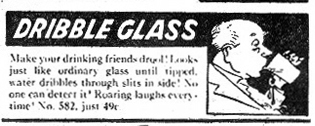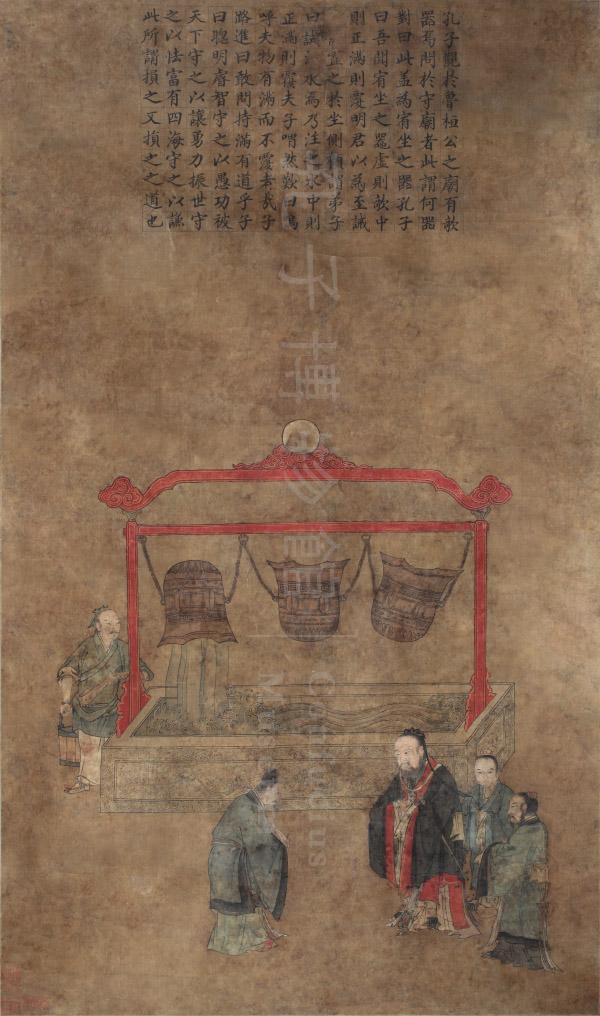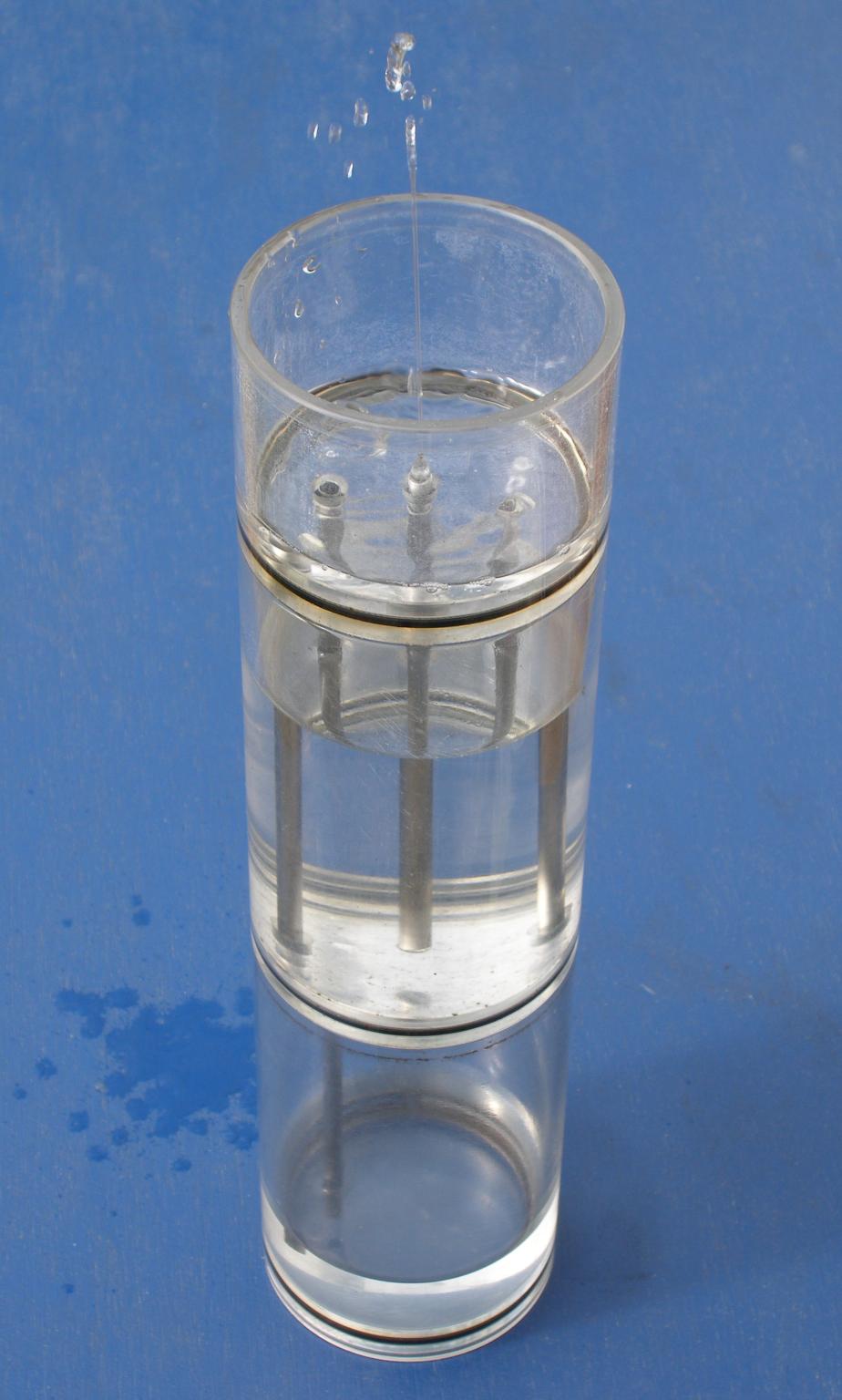|
Pythagorean Cup
A Pythagorean cup (also known as a Pythagoras cup, Greedy Cup, Cup of Justice or Tantalus cup) is a practical joke device in a form of a drinking cup, credited to Pythagoras of Samos. When it is filled beyond a certain point, a siphoning effect causes the cup to drain its entire contents through the base. The cup can be used to learn about greed. Form and function A Pythagorean cup looks like a normal drinking cup, except that the bowl has a central column in it, giving it a shape like a Bundt pan. The central column of the bowl is positioned directly over the stem of the cup and over a hole at the bottom of the stem. A small open pipe runs from this hole almost to the top of the central column, where there is an open chamber. The chamber is connected by a second pipe to the bottom of the central column, where a hole in the column exposes the pipe to (the contents of) the bowl of the cup. When the cup is filled, liquid rises through the second pipe up to the chamber at the ... [...More Info...] [...Related Items...] OR: [Wikipedia] [Google] [Baidu] |
Dribble Glass
A dribble glass is a drinking glass that has holes hidden in its etched design. The purpose of a dribble glass is for pranks. When a person tilts the glass to take a drink from this glass, they will end up spilling the liquid on their clothing as the drink trickles through the holes. The dribble glass was invented by S.S. Adams. See also *Fuddling cup * List of practical joke topics * Puzzle jug *Pythagorean cup A Pythagorean cup (also known as a Pythagoras cup, Greedy Cup, Cup of Justice or Tantalus cup) is a practical joke device in a form of a drinking cup, credited to Pythagoras of Samos. When it is filled beyond a certain point, a siphoning effect ... References Further reading * External links S.S. Adams Co.- Official site of S.S. Adams Co., the company founded by the inventor of the Dribble Glass Practical joke devices Drinkware {{drinkware-stub ... [...More Info...] [...Related Items...] OR: [Wikipedia] [Google] [Baidu] |
Practical Joke Devices
Pragmatism is a philosophical tradition that considers words and thought as tools and instruments for prediction, problem solving, and action, and rejects the idea that the function of thought is to describe, represent, or mirror reality. Pragmatists contend that most philosophical topics—such as the nature of knowledge, language, concepts, meaning, belief, and science—are all best viewed in terms of their practical uses and successes. Pragmatism began in the United States in the 1870s. Its origins are often attributed to the philosophers Charles Sanders Peirce, William James, and John Dewey. In 1878, Peirce described it in his pragmatic maxim: "Consider the practical effects of the objects of your conception. Then, your conception of those effects is the whole of your conception of the object."Peirce, C.S. (1878), " How to Make Our Ideas Clear", ''Popular Science Monthly'', v. 12, 286–302. Reprinted often, including ''Collected Papers'' v. 5, paragraphs 388–410 and ... [...More Info...] [...Related Items...] OR: [Wikipedia] [Google] [Baidu] |
Fluid Dynamics
In physics and engineering, fluid dynamics is a subdiscipline of fluid mechanics that describes the flow of fluids— liquids and gases. It has several subdisciplines, including ''aerodynamics'' (the study of air and other gases in motion) and hydrodynamics (the study of liquids in motion). Fluid dynamics has a wide range of applications, including calculating forces and moments on aircraft, determining the mass flow rate of petroleum through pipelines, predicting weather patterns, understanding nebulae in interstellar space and modelling fission weapon detonation. Fluid dynamics offers a systematic structure—which underlies these practical disciplines—that embraces empirical and semi-empirical laws derived from flow measurement and used to solve practical problems. The solution to a fluid dynamics problem typically involves the calculation of various properties of the fluid, such as flow velocity, pressure, density, and temperature, as functions of space and ti ... [...More Info...] [...Related Items...] OR: [Wikipedia] [Google] [Baidu] |
Ancient Inventions
Ancient history is a time period from the beginning of writing and recorded human history to as far as late antiquity. The span of recorded history is roughly 5,000 years, beginning with the Sumerian cuneiform script. Ancient history covers all continents inhabited by humans in the period 3000 BCAD 500. The three-age system periodizes ancient history into the Stone Age, the Bronze Age, and the Iron Age, with recorded history generally considered to begin with the Bronze Age. The start and end of the three ages varies between world regions. In many regions the Bronze Age is generally considered to begin a few centuries prior to 3000 BC, while the end of the Iron Age varies from the early first millennium BC in some regions to the late first millennium AD in others. During the time period of ancient history, the world population was already exponentially increasing due to the Neolithic Revolution, which was in full progress. While in 10,000 BC, the world population ... [...More Info...] [...Related Items...] OR: [Wikipedia] [Google] [Baidu] |
Qiqi (tilting Vessel)
The ''qīqì'' (, "tilting vessel" or "tipping vessel") was an ancient Chinese ceremonial utensil that automatically overturned and spilled its contents once it reached capacity, thus symbolizing moderation and caution. Both Confucian and Daoist Chinese classics include a famous anecdote about the first time Confucius saw a tilting vessel. In the Confucian tradition (e.g., '' Xunzi'') it was also named ''yòuzuò zhī qì'' (宥座之器, "vessel on the right of one's seat"), with three positions, the vessel tilts to one side when empty, stands upright when filled halfway, and overturns when filled to the brim—illustrating the philosophical value of the golden mean. In the Daoist tradition, the tilting vessel was named ''yòuzhī'' (宥卮, "urging goblet" or "warning goblet"), with two positions, staying upright when empty and overturning when full—illustrating the metaphysical value of emptiness, and later associated with the Zhuangzian ''zhīyán'' (卮言, " goblet wo ... [...More Info...] [...Related Items...] OR: [Wikipedia] [Google] [Baidu] |
Soxhlet Extractor
A Soxhlet extractor is a piece of laboratory apparatus invented in 1879 by Franz von Soxhlet. It was originally designed for the extraction of a lipid from a solid material. Typically, Soxhlet extraction is used when the desired compound has a ''limited'' solubility in a solvent, and the impurity is insoluble in that solvent. It allows for unmonitored and unmanaged operation while efficiently recycling a small amount of solvent to dissolve a larger amount of material. Description A Soxhlet extractor has three main sections: a percolator (boiler and reflux) which circulates the solvent, a thimble (usually made of thick filter paper) which retains the solid to be extracted, and a siphon mechanism, which periodically empties the thimble. Assembly # The source material containing the compound to be extracted is placed inside the thimble. # The thimble is loaded into the main chamber of the Soxhlet extractor. # The extraction solvent to be used is placed in a distillation flask. # Th ... [...More Info...] [...Related Items...] OR: [Wikipedia] [Google] [Baidu] |
Puzzle Jug
A puzzle is a game, problem, or toy that tests a person's ingenuity or knowledge. In a puzzle, the solver is expected to put pieces together ( or take them apart) in a logical way, in order to arrive at the correct or fun solution of the puzzle. There are different genres of puzzles, such as crossword puzzles, word-search puzzles, number puzzles, relational puzzles, and logic puzzles. The academic study of puzzles is called enigmatology. Puzzles are often created to be a form of entertainment but they can also arise from serious mathematical or logical problems. In such cases, their solution may be a significant contribution to mathematical research. Etymology The ''Oxford English Dictionary'' dates the word ''puzzle'' (as a verb) to the end of the 16th century. Its earliest use documented in the ''OED'' was in a book titled ''The Voyage of Robert Dudley...to the West Indies, 1594–95, narrated by Capt. Wyatt, by himself, and by Abram Kendall, master'' (published circa 1595). ... [...More Info...] [...Related Items...] OR: [Wikipedia] [Google] [Baidu] |
List Of Practical Joke Topics
This is a list of practical joke topics (also known as a prank, gag, jape or shenanigan) which are mischievous tricks or jokes played on someone, typically causing the victim to experience embarrassment, perplexity, confusion, or discomfort. Practical jokes differ from confidence tricks or hoaxes in that the victim finds out, or is let in on the joke, rather than being fooled into handing over money or other valuables. Practical jokes or pranks are generally lighthearted, reversible and non-permanent, and aim to make the victim feel foolish or victimised to a degree, but may also involve cruelty and become a form of bullying if performed without appropriate finesse. Practical jokes 0–9 * 2004 Harvard–Yale prank A * Alhokm Baad Almozawla * April Fools' Day * List of April Fools' Day jokes B * Berners Street hoax * Bingo Shooting Device * Black fax C * Caltech–MIT rivalry * Candid Camera * Capping stunt * Josiah S. Carberry * Chewing gum bug * Chinese fin ... [...More Info...] [...Related Items...] OR: [Wikipedia] [Google] [Baidu] |
Heron's Fountain
Heron's fountain is a hydraulic machine invented by the 1st century AD inventor, mathematician, and physicist Heron of Alexandria (also known as Hero of Alexandria). Heron studied the pressure of air and steam, described the first steam engine, and built toys that would spurt water, one of them known as Heron's fountain. Various versions of Heron's fountain are used today in physics classes as a demonstration of principles of hydraulics and pneumatics. Construction In the following description, call the 3 containers: * (A) Top: basin * (B) Middle: water supply * (C) Bottom: air supply And three pipes: * P1 (on the left in the picture) from a hole in the bottom of basin (A) to the bottom of air supply container (C) * P2 (on the right in the picture) from the top of the air supply container (C) to the top of the water supply container (B) * P3 (in the middle of the picture) from the bottom of the water supply container (B), up through the bottom of the basin (A) to a height ... [...More Info...] [...Related Items...] OR: [Wikipedia] [Google] [Baidu] |
Fuddling Cup
A fuddling cup is a three-dimensional puzzle in the form of a drinking vessel, made of three or more cups or jugs all linked together by holes and tubes. The challenge of the puzzle is to drink from the vessel in such a way that the beverage does not spill. To do this successfully, one must drink from the cups in a specific order. Fuddling cups were especially popular in 17th- and 18th-century England. See also *Dribble glass *Puzzle jug A puzzle is a game, problem, or toy that tests a person's ingenuity or knowledge. In a puzzle, the solver is expected to put pieces together ( or take them apart) in a logical way, in order to arrive at the correct or fun solution of the puzzl ... * Pythagorean cup References External links Mechanical puzzles Drinkware {{drinkware-stub ... [...More Info...] [...Related Items...] OR: [Wikipedia] [Google] [Baidu] |
Pythagorean Cup Sold In Crete
Pythagorean, meaning of or pertaining to the ancient Ionian mathematician, philosopher, and music theorist Pythagoras, may refer to: Philosophy * Pythagoreanism, the esoteric and metaphysical beliefs purported to have been held by Pythagoras * Neo-Pythagoreanism, a school of philosophy reviving Pythagorean doctrines that became prominent in the 1st and 2nd centuries AD * Pythagorean diet, the name for vegetarianism before the nineteenth century Mathematics * Pythagorean theorem * Pythagorean triple * Pythagorean prime * Pythagorean trigonometric identity * Table of Pythagoras, another name for the multiplication table Music * Pythagorean comma * Pythagorean hammers * Pythagorean tuning Other uses * Pythagorean cup * Pythagorean expectation, a baseball statistical term * Pythagorean letter Upsilon (, ; uppercase Υ, lowercase υ; el, ''ýpsilon'' ) or ypsilon is the 20th letter of the Greek alphabet. In the system of Greek numerals, grc, Υʹ, label=none has a ... [...More Info...] [...Related Items...] OR: [Wikipedia] [Google] [Baidu] |






